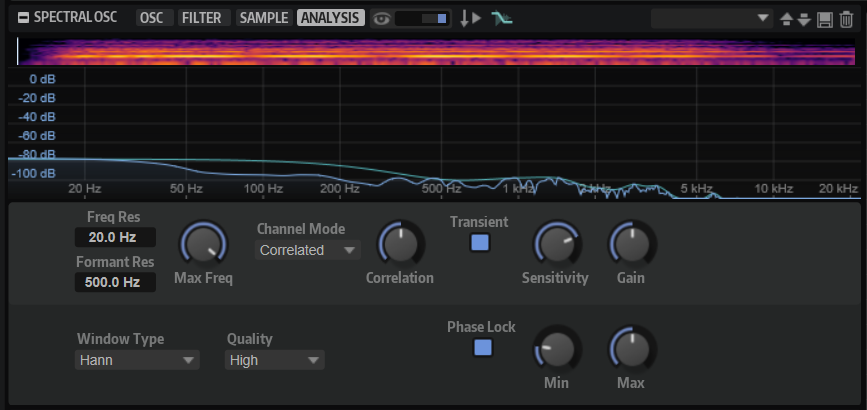Analysis Tab
On the Analysis tab, you can adjust the time stretching algorithm that is used for the spectral zone, which means that you define the audio quality of the zone. For example, you can minimize unwanted artifacts or explicitly allow them to generate special sound effects.

Spectrum Display
The spectrum display shows the spectrum at the current playback position. To adjust the position, click in the small wave/spectrogram display at the top. Furthermore, the display shows the formant resolution curve, which gives you visual feedback on how closely the formant envelope follows the spectrum gains.
Analysis Window
Before a sample is transformed into the spectral domain, an analysis window must be applied. The shape and size of this window determines how well the frequencies in the sample can be observed. If the window is not large enough, the frequency resolution is too low, the sound is unstable, and you hear artifacts that are often described as musical noise. Temporal events such as transients also depend on the window size.
The larger the window size, the lower the temporal resolution. A low temporal resolution results in less sharp, sometimes blurred-sounding transients. The effect of this can be heard as pre and post echos around transients in the time-stretched audio. This window is defined by the parameters Frequency Resolution and Window Type.
- Frequency Resolution
-
This parameter specifies how close two frequencies can be for them to be reliably detected, and it determines the lowest detectable frequency in the sample. The window size automatically adapts to the sample rate of the analyzed sample. For example, the window size for a 96 kHz sample is twice as large as the window size for a sample with 48 kHz.
-
If you experience unstable sound or musical noise, try to increase the frequency resolution (< 20 Hz).
-
If you hear pre and post echos around transients, try to decrease the frequency resolution (> 20 Hz).
-
- Max Frequency
-
Allows you to limit the playback to the frequency range that is effectively used. This way, it is not necessary to compute the full spectrum, which can reduce the required processing power.
- Window Type
-
Allows you to select the window type. This affects the shape of the window, which in turn influences the frequency resolution. This parameter also determines the amount of suppression of noise artifacts during the analysis.
The window types on the menu are sorted from the best frequency resolution with the lowest artifact suppression (Rectangle) to the lowest frequency resolution with best artifact suppression (Blackman-Harris).
Try out different Window Type settings to find the overall frequency resolution and artifact suppression that suits your work.
Transient Detection
Transient detection preserves transients and minimizes artifacts, such as the smearing of transients.
- Transient Detection On/Off
-
Activate this parameter to minimize artifacts around the transients.
- Transient Sensitivity
-
Transient Sensitivity sets a sensitivity for the transient detection. The higher the value, the more transients are detected. The detected transients are unaffected by time stretching, which results in a more defined sound.
Different types of samples need different amounts of transient sensitivity. For example, drums need a high Transient Sensitivity setting, but vocals also sound clean with a lower Transient Sensitivity setting. Reduce the Transient Sensitivity if you are faced with artifacts, such as double transients in drum loops, or if you hear clicks or pops in your samples.
At 0%, no transients are detected.
- Transient Gain
-
Adjusts the gain that the detected transients are played with.
Higher values accent the transients, lower values soften them.
Phase Lock
Phase Lock keeps the phases as close to the original sample as possible. Without phase locking, the original phase of the sample can get lost, resulting in a “smearing” sound. The time-stretching algorithm adaptively uses the optimum Phase Lock amount between the set minimum and maximum values.
- Phase Lock On/Off
-
Activates/Deactivates phase locking.
TipDeactivate Phase Lock to free CPU time if you want to use the Multi-Oscillator mode of the Spectral zone.
- Phase Lock Min/Phase Lock Max
-
These parameters determine the minimum and the maximum amount of phase locking during playback.
NoteIf Phase Lock Min is greater than Phase Lock Max, the time-stretch algorithm uses the fixed amount of Phase Lock Min.
Channel Mode and Correlation
The correlation between the left and right stereo channels can get lost, resulting in a much wider stereo image. While this can be interesting for sound design, it is undesirable for loops of acoustic drums, for example.
- Channel Mode
-
Determines how the channels are treated.
-
If Independent is selected, each channel is treated separately, and the channel correlation is not restored.
-
Select Correlated to restore the correlation for complex material.
-
Select Joint to restore the correlation when you are working with material where you seek a very stable mid.
-
- Channel Correlation
-
Allows you to set the amount of channel correlation that is restored when Correlated or Joint is selected as the Channel Mode.
Pitch Shifting
The time stretching algorithm that is used for the spectral zone is also capable of altering the pitch of the sample independently from its length.
- Resample Quality Mode
-
This parameter determines the resample quality for pitch-shifting. With a playback speed above 75% and pitch intervals below -/+1 octave, you can use the settings Standard and High. If you want to apply more pitch shifting, that is, if the playback speed is below 75% and the pitch intervals are above -/+1 octave, use Best.
NoteThe higher this setting, the more CPU time is required.
Presets
With the preset controls in the top right, you can save the settings of the Analysis tab, to quickly adapt them to different sample material or to change the playback performance requirements, for example.